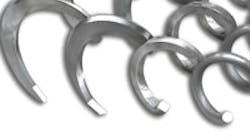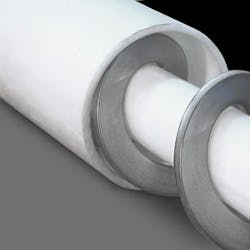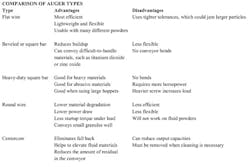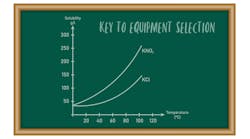Get the Most from Your Flexible Screw Conveyor
Due to their relatively low cost and uncomplicated construction, flexible screw conveyors are very popular with manufacturers. In these units, a screw (also called an auger), driven by an electric motor, rotates within a tubular housing. The screw is the only part that moves.
Despite the conveyors' simplicity and straightforward operation, many end-users overlook important factors that potentially could lead to poor performance, excessive power usage, severe wear and material degradation. To avoid such issues, it's essential to consider all system parameters when selecting conveyor options. Only then can you ensure a correct and successful installation that achieves maximum operational efficiency.
Figure 1. Screws generally are available in four configurations: flat wire, beveled wire, square bar and round wire.
THE BASICSA flexible screw conveyor has a helicoid screw that rotates inside a fixed tube. Screw conveyors typically range in diameter from 2½ to 8 inches, and can be used for horizontal transports of up to 80 feet and inclines of up to 60°. An 8-in.-diameter unit can handle 1,800 ft3/h at 360 rpm at a 45° angle. The flexible screw is made from stainless steel and comes in a variety of configurations. As the screw rotates, it creates directional force that moves the product through the tube. At the same time, it creates centrifugal force that pushes the material against the tube's wall.The characteristics of the material being conveyed are extremely important considerations when selecting any conveyor. Flexible screw conveyors can move many types of materials, such as powders, crystals, flakes, granules, pellets and irregular shapes. However, you still must assess how the material will affect the conveyor as well as how the conveyor might affect the material. For example, certain materials, such as sugar or salt, have the potential to create friction within the flexible screw conveyor. This can cause crushing, heating or chipping of some particles during transport. Moreover, material friction can result in overtaxing of the conveyor's motor, increasing wear and eventually leading to failure if left unchecked. Or the actual material being conveyed could build up on the screw and make it stall.Figure 2. By restricting the amount of material in the conveyor, this design alleviates load on the screw.
TYPES OF SCREWSAugers come in many designs, each addressing the challenges presented by different material characteristics. To get the best results possible from your flexible screw conveyor, you must select the auger type that best suits the material you need to convey. Here's a rundown on the basic types (Figure 1): • Flat wire. These augers are the most common type used. Made of rectangular wire about ¼-in. thick, they can handle a wide variety of powders ranging in bulk density up to 60 lb/ft3. The flat conveying surface applies a more positive forward directional force on the product being conveyed and reduces the outward force against the tube wall. • Beveled or square bar. This type of auger is designed specifically to convey difficult-to-handle or fragile material with minimal product degradation or damage. The beveled auger must be installed straight. It rotates at a much lower rpm, typically 360–450 rpm. • Heavy-duty square bar. Usually 3/8-, ½- or even ¾-in. thick, wound into sections and welded as needed, these screws can cope with heavy and abrasive materials and suit large hoppers.• Round wire. Made from a coiled round bar, these screws mainly are used for heavy or highly abrasive materials. The biggest benefits of this auger design are its strength and flexibility, which minimizes the load imposed on it by material weight or size or particle shape. The design creates high slippage and stronger outward forces on the conveyed product. • Centercore. A small tube placed in the center of the screw extends the full length of this auger (Figure 2). By restricting the space available, the centercore reduces the amount of material that can enter the conveyor, which in turn decreases the load imposed upon the screw. Use a centercore when conveying very dense products or highly aerated or fluid product.Table 1 summarizes the advantages and disadvantages of the various types of augers. Table 2 lists some of the materials each auger type suits.ADVANTAGES AND LIMITATIONSThe flexible screw conveyor is the best choice for many batch processing applications. However, as with any type of conveyor, when selecting equipment you should consider advantages and limitations:Advantages:• well suited for horizontal and vertical conveying;• easily transports many free- and non-free-flowing bulk materials;• low cost;• takes up very little floor space;• easy to clean;• allows for flexible installations (conveyors 4-in. and smaller can be curved within a specific bend radius, and inlet hopper angles also can be varied);• causes low-to-moderate material degradation; and• ensures a dust-tight system, with hopper options to ensure that product remains within the process.Limitations: • residual product left in the casing;• height and length limits; and• different screws may be required when conveying multiple products with the same conveyor.Figure 3. Author shows how tilt-down design makes screw removal easy.
Table 1. Each screw type offers a distinct set of advantages and limitations.
Table 2. The various types of screws suit specific types of materials.
CHOOSE WISELYFlexible screw conveyors are a cost-effective dependable choice for conveying a wide range of materials. Their rugged simple design fosters reliable service, provides user-friendly operation and keeps maintenance low.By first considering several important factors — material characteristics (e.g., whether heavy granules or light powder, wet and sticky or dry and aerated, abrasive or corrosive) and process criteria (e.g., whether continuous or batch operation, necessary incline and run length) — you can ensure selection of a flexible screw conveyor that suits your application and provides proper operation and optimal service.
MIKE ZELUFF is a product manager for Hapman, Kalamazoo, Mich. E-mail him at [email protected].







